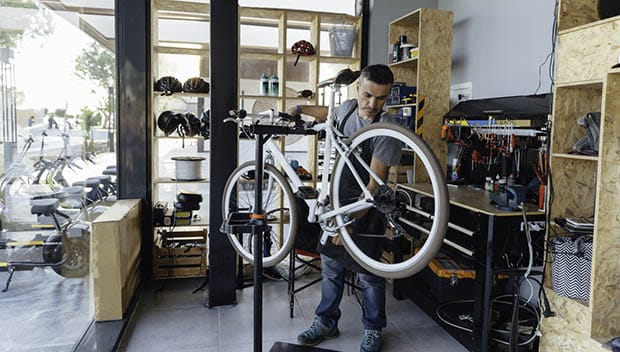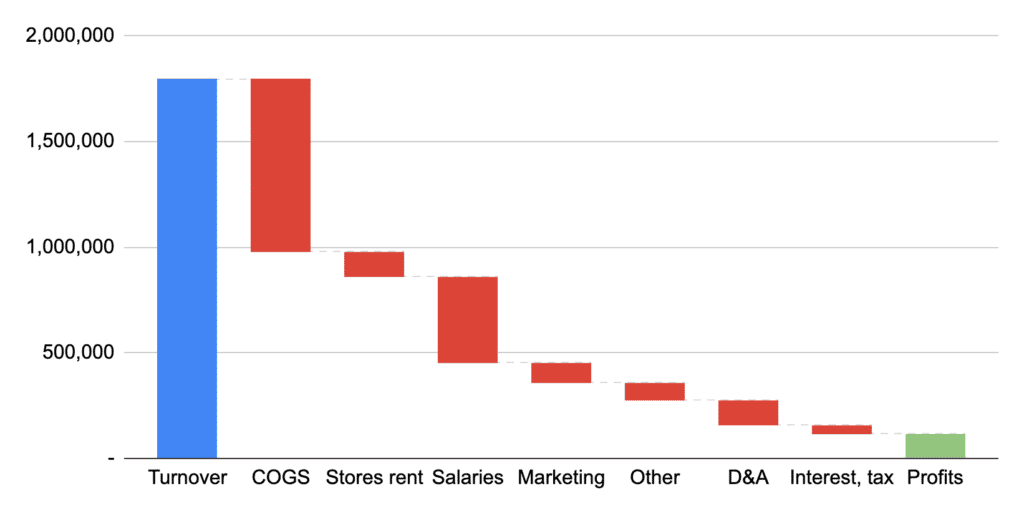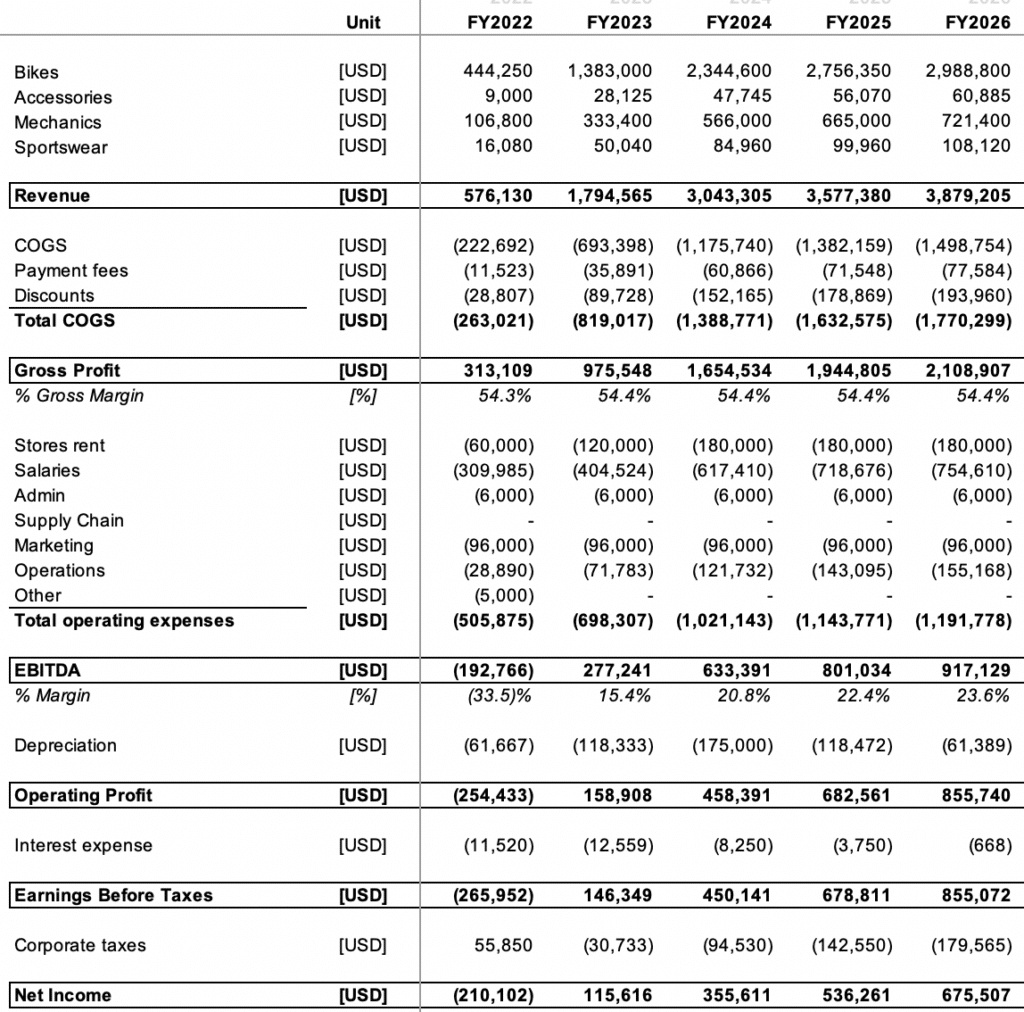How Much Profits Can you Make with a Bike Shop?

When you plan on starting a bike shop it becomes important to understand how to turn revenue into profits. Simply put, you must figure out the revenue you need to generate to reach break-even and then be profitable.
With a total industry size of $6.9 billion in 2021, the US retail bike industry is expected to grow at a CAGR of 6.12% from 2022 to 2027. No wonder the sector is very attractive for many entrepreneurs!
What does this mean for your business? How much revenues can you expect to generate? More importantly: how much profits can you realistically make with a bike shop?
In this article we’ll look into the average revenues and profit margins of bike shop companies in the US. We’ll also look into how you can accurately forecast your turnover and profits. Let’s dive in!
What is the average turnover for a bike shop?
With a market size of $6.9 billion and 7,000 companies across the US, the average revenue for a bike shop is $985,000 per year.
Yet, remember that this is only an average and the annual turnover of a bike shop can differ depending on the location and size of the shop. Also, revenue will differ depending on the type of brand and bikes you offer, whether you sell and/or rent bikes, the products you sell (sportswear, bikes, accessories, etc.)
According to Bicycle Retailer, the average take-home salary of a bicycle store owner is approximately $49,877 a year
What is the average profit margin for a bike shop?
According to the National Bicycle Dealers Association the (gross) profit margin for bike-related goods is 49.7% and 43% for sportswear and clothing.
Yet, this doesn’t tell us much about the net profit margin of a bike shop: the profit margin after all expenses have been paid. Indeed, the 49.7% above is the margin you make on a sale (after paying your supplier) yet you still need to pay for costs like rent, marketing, your own salary, etc.
Let’s now have a look at how much it costs to operate a bike shop.
How much does it cost to run a bike shop?
When you open a bike shop, you should expect certain recurring costs to keep the business running. They include:
- COGS: You must purchase bikes, clothing, and accessories from manufacturers and/or wholesalers. As explained earlier, this represents around 45-50% of your total turnover (including payment processing fees, shipping costs, etc.).
- Store(s) rent: You will need to pay a monthly rent for the space you have leased for your bike shop. Depending on the location of your store, this represents anywhere from 5% to 10% of sales. If you decide to buy the real estate instead, you will have to pay for similar costs yet this time as mortgage payments and debt repayment costs.
- Staff: You will have several employees such as a mechanic, a sales expert, etc. On average you can expect to spend 25-30% of your sales in staff costs.
- Marketing: You must keep spending on advertising and marketing your bike shop to keep attracting new customers (both online e.g. online paid ads, social media ; and offline marketing e.g. newspapers ads, magazines, etc.)
- Other operating costs: there are various costs to run a store to take into account as well like bookkeeping, POS software costs, insurance, utility bills, etc.
- Depreciation & amortization expenses (D&A): the depreciation of your assets (the building, furniture, the bikes themselves if you rent them for example, etc.)
On average, it costs around $43,150 per month to run a bike shop in the US. To understand how much it costs to start and operate a bike store, read our article here.
We’re including below the sales to net profit breakdown of a bike shop with 2 stores generating a monthly turnover of ~$170,000 and a net profit margin of 7%:

How to forecast profits for a bike shop?
In order to calculate profits for a bike store, you must first forecast sales and expenses.
Profits = Sales – Expenses
Forecasting sales for a bike shop
Forecasting sales for such a business requires 2 assumptions:
- the number of orders (customers)
- the average order value (the average value of a purchase)
Revenue = # orders x Average order value
For example, if you operate 1 bike shop and there are 30 orders per day on average with an average order value of $150 (you sell both bikes and lower-priced accessories and sportswear), then daily revenue is:
Revenue = 30 orders x $150 = $4,500
In other words, your monthly revenue is about $112,500 if you operate 6 days a week.
For more information on how to build financial forecasts for a bike shop, read our article here.
Forecasting expenses for a bike shop
There are 2 types of expenses for a bike shop company:
- Variable expenses: these are the COGS as explained earlier (the cost to source the bikes, accessories and other products from the manufacturer and/or reseller). They grow in line with your revenue: if your turnover increases by 10%, variable expenses grow by 10% as well
- Fixed expenses: salaries, rent, marketing and all the other operating costs listed above
Calculating profits for a bike shop
When we refer to profits, we usually refer to EBITDA (Earnings before interests, taxes, depreciation and amortization) as it represents the core profitability of the business, excluding things such as debt interests, non cash expenses and other non-core expenses.
In order to get to EBITDA, we use the following formula:
EBITDA = Revenue – COGS – Operating Expenses
We’ve included below the illustrative profit-and-loss of a bike shop with 3 stores (from our financial model template for bike shops).
As we just saw, gross margin is around 50%. EBITDA and net profit margins then vary significantly from one shop to another. In general, bike shop companies that operate multiple stores tend to have higher margins vs. single shops.
That’s why in our example below EBITDA margin can reach 20-25% at scale and Net Profit margin can go up to 10-15% even. In comparison, a single shop owner would reasonably expect net profits of about 5-10% of sales. That’s because some of the fixed expenses (e.g. salaries) can be shared across stores to generate economies of scale.

How to increase profits for a bike shop?
To become a profitable business, you must try to increase the sales of your shop. Here are some strategies that you can use to increase your revenue:
- Stay abreast with trends: Understanding market trends is important. For instance, if there is an increased demand for hybrid bikes and mountain bikes in your area, trying to push road bikes will not drive enough customers
- Allow bike rentals: Understand that not everyone is willing to purchase a bike. Several hobbyists will love to rent a bike for a few hours or a few days instead of purchasing a new one. Allowing bike rentals can attract those customers and open a recurring revenue stream for you
- Niche selection: It is okay to open an all-in-one store, but if you consider opening a niche, there will be loyal customers who will stick with you no matter what comes. You can consider settling for a luxury niche or the budget niche. Your decision must be based on the demand in your area
- Specialize: Quite similar to niche selection, you must also consider specializing in a specific type of bike. For instance, you may specialize in mountain bikes, European brands, women’s bikes, etc. Specialization helps to bring in a loyal crowd
- Get listed on Google: Get your business listed on Google My Business. This can help local people to find you easily
- Go social: Open social media profiles and share tips and tricks to attract a fan following. You may even consider opening a YouTube channel that can help you to bring in a separate revenue stream
- Spend on digital ads: Social media ads and search engine ads can help you to reach more potential customers by increasing your business visibility
- Participate in cycling events: If there are cycling events in your locality consider sponsoring. Alternatively, you can consider organizing events to increase awareness





